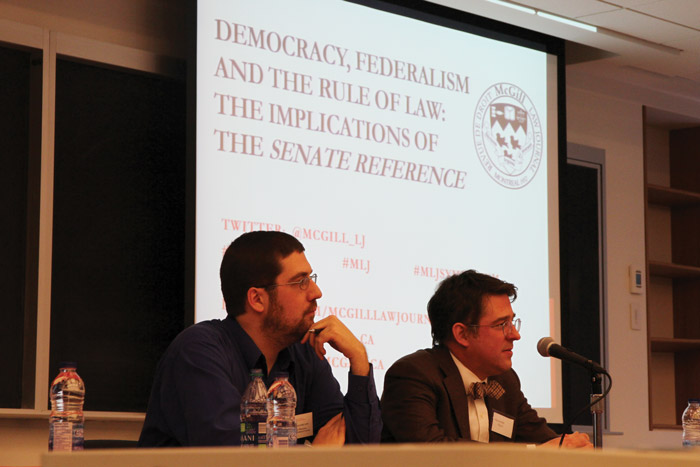On Friday, the McGill Law Journal hosted “Democracy, Federalism, and the Rule of Law: The Implications of the Senate Reference,” a symposium that saw presenters from law faculties across Canada and the United States discuss the role of the Supreme Court of Canada in deciding how amendments could be made to the Canadian Constitution.
The panel was held in response to the Supreme Court of Canada’s April 2014 ruling that constitutional amendments on elections and term limits would only be valid if provinces signed their agreement to the amendment procedure. The discussion was hosted by Emmett Macfarlane, professor of political science at the University of Waterloo, and Alexander Pless, a litigator for the Attorney General of Canada at the Department of Justice and a McGill lecturer.
The ruling was made in response to the Harper government’s attempt to reform the Senate.
“The Court […] emphasized the Senate’s role as a complementary rather than competitive body and noted that any changes that altered this role should be subject to provincial consent,” Macfarlane said.
Patrick Baud, a first year law student attending the event, explained the impact of the decision on Canadian citizens.
“This decision matters so much […because] it’s the first time the Supreme Court has really comprehensively interpreted the rules in our constitution for how we change our institutions,” Baud said. “So if we ever wanted to change the way the prime minister gets to advise the Governor General about how to do things, or change the way that the House of Commons is structured, or make any of the kinds of changes to national institutions which people have talked about for many years in Canada, this decision is about the rules that would apply to that.”
Pless defined the concept of constitutional architecture and contrasted it with that of the living tree doctrine, explaining that the wider scope of constitutional architecture could make it more difficult to change amending procedures.
“This new notion that [the Supreme Court] introduced is an idea that the constitution has an architecture that can’t be changed without a constitutional amendment,” Pless said. “It [states that the] constitution is not a static document, but an instrument capable of adapting with the times by way of evolutionary interpretation within the natural limits of the text, which accommodates and addresses the realities of modern life.”
Macfarlane identified two primary issues with the ruling, both related to the concept of constitutional architecture. He argued that the Court’s approach introduced unnecessary ambiguity into its elaboration of the various amending procedures in Part 5 of the Constitution. He also criticized the amendment procedures’ potential for interpretation.
Ultimately, Macfarlane’s concern was the effect of the ruling on the constitution’s clarity and its capacity for evolution.
“[The ruling] means that the Court has arguably worsened the constitutional stasis that Canada finds itself in, and the Court’s reliance on constitutional architecture obscures rather than clarifies the dividing line between the various amending procedures,” Macfarlane said.









